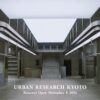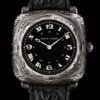
Rewrite
How would you describe your personal artistic DNA?
I am a visual artist, and I specialise in creating works exclusively from plants. I draw my inspiration and my palette from the poetry of the botanical world. The wilderness in our cities is my field of exploration. I strive through my works to spotlight the nature in my surroundings.
How does your Vietnamese heritage influence your work? What role does the natural world play into your work?
I lived in Vietnam until I was ten. In Saigon, I experienced the pleasures of playing in nature, in complete freedom. I spent most of my time barefoot, climbing trees. My childhood unfolded outdoors, in the open air, without too many parental restrictions. It was in these carefree moments that my connection to the plant world was forged. Thanks to my art, I’ve found a way to preserve this bond.
Nature is the matrix of all my work. I create installations using very common plants found in the city – such as dandelions, salsifies, thistles and clover. The greenery we no longer notice, sometimes considered weeds, that we often trample underfoot, is what I pick and dry and compose with, primarily intending to preserve its original beauty.
What inspired your Dior Lady Art design?
I wanted this bag to evoke the essence of my oeuvre, the starting point of all my pieces, namely the gathering of wild plants. I didn’t want to change its shape, but rather its appearance, so that it could evoke harvested treasures. The bag became a support for wild plants. I sought to express the diversity of species that I can find in the urban wastelands where I collect the vegetation with which I create. This is why, in the foreground, there’s a wire fence that could be opened to enter that secret garden. The notion of that mesh is also reminiscent of Lady Dior’s emblematic cannage. I wanted to hide seeds in the bag, like the ones I glean on my walks. The charms include my favourite plants: a maple samara, a four-leaf clover of course, a poppy seed pod and a dandelion – a real dandelion seed that I gilded with gold leaf. It’s as if a wish were tucked inside each bag. Like a little talisman.
What specialist techniques did you employ in the making of this bag?
As with all my personal projects, I started from the harvesting phase in order to be able to work with real plants. I created the exact compositions to be found on the bag. It’s a work of plant imprints on Earth, with wire mesh in the foreground, followed by a plaster cast. Using a leather-pressing process, the Dior teams were able to reproduce exactly the movement of the plants in my compositions. And this pressed leather became our playground. We added the gold found on my work, along with the texture of the embroidery.
I’ve always dreamed of working with embroidery. And the possibilities offered to me by the Dior Ateliers were beyond my expectations. I wanted to reflect the plants I work with: delicate, luminous, almost fragile, and to maintain this natural aspect. That’s why the embroideries feature plant fibres like linen, reminiscent of grasses.
Leaf gilding was also important, as it’s a technique I often use. Here, it was applied to enhance the latticework. The clover, poppy and maple samphire that we slipped into the charms are truer than life. These metal replicas are reminiscent of a process I use in my work: electroplating. Working with vegetal leather was also important to me. That’s why apple leather was used.
What was it like blending your own aesthetic with Dior’s for Dior Lady Art?
The collaboration flowed naturally, since my proposal was brought to life, and it was a great joining of forces on a human level, thanks to the professionalism and savoir-faire of the people I was working with. All those who took part in the creative process right up to the production of this bag that is like a jewel case.
How does it feel to be honoured as one of this year’s selected artists for the Dior Lady Art project?
I was delighted to be able to work with the house of Dior and its ateliers, which enabled me to discover the infinite possibilities that can be achieved through exceptional skills such as embroidery. This led to a collaboration on works for my new carte blanche exhibition, which I’m currently presenting in Versailles at the Espace Richaud.
Photography courtesy of Dior.
in HTML format, including tags, to make it appealing and easy to read for Japanese-speaking readers aged 20 to 40 interested in fashion. Organize the content with appropriate headings and subheadings (h1, h2, h3, h4, h5, h6), translating all text, including headings, into Japanese. Retain any existing
tags from
How would you describe your personal artistic DNA?
I am a visual artist, and I specialise in creating works exclusively from plants. I draw my inspiration and my palette from the poetry of the botanical world. The wilderness in our cities is my field of exploration. I strive through my works to spotlight the nature in my surroundings.
How does your Vietnamese heritage influence your work? What role does the natural world play into your work?
I lived in Vietnam until I was ten. In Saigon, I experienced the pleasures of playing in nature, in complete freedom. I spent most of my time barefoot, climbing trees. My childhood unfolded outdoors, in the open air, without too many parental restrictions. It was in these carefree moments that my connection to the plant world was forged. Thanks to my art, I’ve found a way to preserve this bond.
Nature is the matrix of all my work. I create installations using very common plants found in the city – such as dandelions, salsifies, thistles and clover. The greenery we no longer notice, sometimes considered weeds, that we often trample underfoot, is what I pick and dry and compose with, primarily intending to preserve its original beauty.
What inspired your Dior Lady Art design?
I wanted this bag to evoke the essence of my oeuvre, the starting point of all my pieces, namely the gathering of wild plants. I didn’t want to change its shape, but rather its appearance, so that it could evoke harvested treasures. The bag became a support for wild plants. I sought to express the diversity of species that I can find in the urban wastelands where I collect the vegetation with which I create. This is why, in the foreground, there’s a wire fence that could be opened to enter that secret garden. The notion of that mesh is also reminiscent of Lady Dior’s emblematic cannage. I wanted to hide seeds in the bag, like the ones I glean on my walks. The charms include my favourite plants: a maple samara, a four-leaf clover of course, a poppy seed pod and a dandelion – a real dandelion seed that I gilded with gold leaf. It’s as if a wish were tucked inside each bag. Like a little talisman.
What specialist techniques did you employ in the making of this bag?
As with all my personal projects, I started from the harvesting phase in order to be able to work with real plants. I created the exact compositions to be found on the bag. It’s a work of plant imprints on Earth, with wire mesh in the foreground, followed by a plaster cast. Using a leather-pressing process, the Dior teams were able to reproduce exactly the movement of the plants in my compositions. And this pressed leather became our playground. We added the gold found on my work, along with the texture of the embroidery.
I’ve always dreamed of working with embroidery. And the possibilities offered to me by the Dior Ateliers were beyond my expectations. I wanted to reflect the plants I work with: delicate, luminous, almost fragile, and to maintain this natural aspect. That’s why the embroideries feature plant fibres like linen, reminiscent of grasses.
Leaf gilding was also important, as it’s a technique I often use. Here, it was applied to enhance the latticework. The clover, poppy and maple samphire that we slipped into the charms are truer than life. These metal replicas are reminiscent of a process I use in my work: electroplating. Working with vegetal leather was also important to me. That’s why apple leather was used.
What was it like blending your own aesthetic with Dior’s for Dior Lady Art?
The collaboration flowed naturally, since my proposal was brought to life, and it was a great joining of forces on a human level, thanks to the professionalism and savoir-faire of the people I was working with. All those who took part in the creative process right up to the production of this bag that is like a jewel case.
How does it feel to be honoured as one of this year’s selected artists for the Dior Lady Art project?
I was delighted to be able to work with the house of Dior and its ateliers, which enabled me to discover the infinite possibilities that can be achieved through exceptional skills such as embroidery. This led to a collaboration on works for my new carte blanche exhibition, which I’m currently presenting in Versailles at the Espace Richaud.
Photography courtesy of Dior.
and integrate them seamlessly into the new content without adding new tags. Ensure the new content is fashion-related, written entirely in Japanese, and approximately 1500 words. Conclude with a “結論” section and a well-formatted “よくある質問” section. Avoid including an introduction or a note explaining the process.


